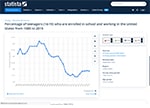Selected Charts on Young Worker Employment, Injuries and Illnesses
These charts include currently available data as well as trend data for multiple years.
| Chart Thumbnail Image | Description |
|---|---|
 |
Numbers of Employed Youth FTEs (Ages 16-24) by year, United States, 2000-2020 This graph shows the numbers of full-time equivalents (FTEs) for employed youth ages 16-24 years in the United States for the time period 2000-2020. (Source: Bureau of Labor Statistics’ Current Population Survey. NIOSH analyses using public microdata files.) |
 |
Distribution of Employed Youth FTEs (Ages 16-17) by Industry Sector, United States, 2020 This chart shows the distribution of full time equivalents (FTEs) for employed youth ages 16-17 years by industry sector in 2020. The industry sector with the largest numbers of employed youth was the services sector, accounting for 58% of all youth employment, mostly in restaurants and other food services. This was followed by trade sector with 24% of youth employment, then construction sector with 5% of youth employment. (Source: Bureau of Labor Statistics’ Current Population Survey. NIOSH analyses using public microdata files.) |
 |
Distribution of Employed Youth FTEs (Ages 16-17) by Occupation, United States, 2020 This chart shows the distribution of full-time equivalents (FTEs) for employed youth ages 16-17 years by occupation in 2020. Service jobs were the primary occupation for 43% of all youth employment. This was followed by sales and office occupations with 31% of youth employment. (Source: Bureau of Labor Statistics’ Current Population Survey. NIOSH analyses using public microdata files.) |
 |
Numbers of Employed Youth (Ages 15-17) by Year, United States This graph shows the numbers of employed youth ages 15- 17 years in the United States for the time period 1994 to 2020. The numbers of employed youth began a steady decline in 2007, however, the number of employed youth has increased in recent years. (Source: Bureau of Labor Statistics’ Current Population Survey. NIOSH analyses using public microdata files.) |
 |
Distribution of Employed Youth (Ages 15-17) by Industry Sector, United States, 2020 This chart shows the number of employed youth ages 15-17 years by industry sector in 2020. The industry sector with the largest numbers of employed youth was accommodation and food services sector, accounting for 45% of all youth employment, mostly in restaurants and drinking establishments. This was followed by the retail trade sector with 22% of youth employment, then the educational and health care and social assistance sector with 7% of youth employment. (Source: NIOSH analyses of Bureau of Labor Statistics’ Current Population Survey using the Employed Labor Force query system) |
 |
Percentage of teenagers (16-19) who are enrolled in school and working in the United States from 1985 to 2020 This chart shows the percentage of youth who were working while being enrolled in school between 1985 and 2020. In 2020, around 17.6 percent of teenagers between the ages of 16 and 19 were employees while enrolled at school in the United States. This is a decrease from the previous year, when 19.2 percent of teenagers were working while at school. |
 |
Data Overview of Young Worker Deaths and Injuries, United States Facts of young worker deaths and nonfatal injuries from different data sources. |
 |
Distribution of Youth (<18 Years) Work-related Injuries and Illnesses Involving Days Away from Work Reported by Private Sector Employers by Industry Sector, United States, 2020 This chart shows employer-reported work-related injuries and illnesses among youth that required at least a day away from work by industry sector in 2020. The industry sector with the largest numbers of injured youth was the leisure and hospitality sector, accounting for 42% of reported injuries and illnesses among youth, with most of these injuries and illnesses in accommodations and food services. The retail trade sector had the second highest frequency with 31% of reported injuries and illnesses among youth. (Source: Bureau of Labor Statistics’ Workplace Injuries and Illnesses using the Databases, Tables & Calculators by Subject (bls.gov).) |
 |
Fatality Rates/100,000 Fulltime Equivalents (FTE) for 15-17 Year-Olds by Year, United States This graph shows work-related injury fatality rates for 15 to 17 year olds in the United States for the time period 1994 to 2020. There is not a clear trend in these numbers, with rises and falls in youth fatality rates over the time period. The highest fatality rate, 3.8 deaths per 100,000 fulltime equivalents, were in the years 1995 and 1999. The lowest fatality rate, 1.3 deaths per 100,000 fulltime equivalents, was in 2017. (Source: Bureau of Labor Statistics (BLS) Census of Fatal Occupational Injuries (CFOI) and BLS Current Population Survey data; additional information at U.S Bureau of Labor Statistics: Injuries, Illnesses, and Fatalities and U.S. Bureau of Labor Statistics: Labor Force Statistics from the Current Population Survey.) |
 |
Rates of Work-related Injuries and Illnesses Treated in Hospital Emergency Departments by Year, 15-17 Year-Olds, United States This graph shows rates for work-related nonfatal injuries and illnesses treated in emergency departments for 15 to 17 year olds in the United States for the time period 2005 to 2020. Rates were generally declining from 2005 to 2009, then variable for the next few years. The highest rate, 4.4 injuries and illnesses per 100 fulltime equivalents, was in 2005. The lowest rate, 1.6 injuries and illnesses per 100 fulltime equivalents, was in 2020. (Source: National Electronic Injury Surveillance System (NEISS)-NIOSH Work Supplement –Work-Related Injury Statistics Query System |
 |
Rates of Work-related Injuries and Illnesses Treated in Emergency Departments by Age Group, United States, 2020 This graph shows rates for work-related nonfatal injuries and illnesses treated in emergency departments by age group in the United States for 2020. The highest rate is seen for workers 18 to 24 years of age, with a rate of 2.3 injuries per 100 fulltime equivalents. The next highest rate is seen for workers 15 to 17 years of age, with a rate of 1.6 injuries per 100 fulltime equivalents. Rates decline for older age groups from a rate of 1.5 injuries per 100 fulltime equivalents for workers 25 to 34 years of age to a rate of 0.9 for workers 65 years and older. (Source: National Electronic Injury Surveillance System (NEISS)-NIOSH Work Supplement –Work-Related Injury Statistics Query System |
 |
Rates of Work-related Injuries Reported by Farm Operators, 15-17 Year-Olds, United States This graph shows rates of work-related injuries among 15 to 17 year olds reported by farm operators in the United States for 7 points in time between 1998 and 2014. Rates steadily declined from a high of 9.6 injuries per 1,000 youth working on farms in 1998 to 3.7 injuries per 1,000 youth working on farms in 2012, before showing an increase in 2014 to 5.6 injuries per 1,000 youth working on farms. (Source: NIOSH Childhood Agricultural Injury Survey.) |
 |
Fatality Rates/100,000 Fulltime Equivalents (FTE) by Age Group, United States, 1994-2020 This graph shows work-related injury fatality rates by age groups ranging from 16-17 year-olds to workers 55 to 64 years of age in the United States for the time period 1994 to 2020. The highest fatality rates are seen for workers 55 to 64 years of age, 5.0 deaths per 100,000 fulltime equivalents, followed by the rate for 45-54 year olds, 3.9 deaths per 100,000 fulltime equivalents. (Source: Fatal injury totals and rates were generated by NIOSH researchers using the Bureau of Labor Statistics (BLS) Census of Fatal Occupational Injuries (CFOI) and BLS Current Population Survey data; additional information at BLS: Census of Fatal Occupational Injuries (CFOI) – Current and BLS: Labor Force Statistics from the Current Population Survey.) |
